Leveraging Resources to Boost Habitat
Positive results usually come slowly for wildlife biologists. Research projects often take several years. Reestablishing trees can take decades before they’re useful to wildlife. Even planted food plots take months to mature.
But Marcus Thibodeau had a much better experience when implementing an NWTF Waterways for Wildlife project in the Packsaddle Wildlife Management Area in western Oklahoma.
“I’m telling you, the turkeys were in there before we were even done working. Before that, they hardly ever used the area,” said Thibodeau, Oklahoma Department of Conservation western turkey coordinator and public lands manager. “And it wasn’t just the turkeys; it wasn’t long before quail showed up. A lot more deer started using the area, too. That project made a huge difference for many kinds of wildlife.”
The biologist is referring to the removal of 2,000 acres of assorted cedar trees along the Canadian River. The trees were mulched from their tops to ground level, killing them and their root systems.
In the two years since that project was completed, Thibodeau said he’s seeing more broods than before and the number of poults per brood also seems better than past years. The river bottom now has stands of beneficial native forbs and grasses growing where a cedar tree jungle once existed.
As productive as the cedar removal project has been for wildlife, Thibodeau is just as happy with how little it consumed from his tight budget within the state’s wildlife department. Under the Waterways for Wildlife framework, NWTF gave $25,000 and helped secure the remaining $75,000 from the federal Pittman-Robertson Fund, resourced with excise taxes on hunting and shooting gear.
That three-to-one match rate between NWTF and a supporting partner is the financial aim of the Waterways for Wildlife program. The overall average ratio of money raised per what’s invested by the NWTF, though, is much greater. “Since 2022, the NWTF has awarded $607,000 in grant funds for 50 projects,” said Annie Farrell, NWTF district biologist for Oklahoma, Texas, Kansas and Nebraska. “Those projects include a total of $24 million in partner matches. That’s a match rate of 40 to 7.1. Across the initiative’s 10-state region, we’ve impacted, or will impact, 42,663 acres and 179.4 miles of streams.”

Farrell said $25,000 is the top award amount the NWTF can contribute to any initiative project. The NWTF has turned to a wide variety of partnerships to keep funds coming for worthwhile projects, some of which are ongoing, with many more to be approved and completed in the coming years.
“We’ve focused a lot on traditional federal partnerships, like with the U.S. Fish and Wildlife Service, the U.S. Army Corps of Engineers, the U.S. Bureau of Land Management, the USDA Forest Service…,” said Jared McJunkin, NWTF director of conservation operations for the central region. “We’ve also partnered with conservation groups like Ducks Unlimited and Trout Unlimited, plus state wildlife agencies and agricultural groups.”
Ambitious - North to South
Scheduled to run through 2032, the program’s overall goal is to improve 75,000 acres of habitat along 1,500 miles of waterways on the Great Plains, McJunkin said. The 10 states within the program range from North Dakota to Texas, and Montana to New Mexico.
Waterways for Wildlife is modeled after the NWTF’s successful Northern Plains Riparian Restoration Initiative, which improved conservation practices on 78,000 acres of riparian areas in North and South Dakota, Wyoming and Montana between 2017 and 2021. That program cost $8.3 million overall and included 94 partners.
McJunkin said the need to improve rivers and streams on the Great Plains is increasingly critical as stream flows have decreased significantly in recent years. Prolonged drought and expanding water demand for irrigation, plus human use in cities, and containment structures like livestock ponds and lakes are likely contributors.
Thirsty Invaders Outcompete Natives
Invasive trees, which outcompete many native plants, have also reached densities that put serious strains on nearby streams and rivers, as well as the region’s underground water table.
McJunkin said while riparian areas make up only about 2% of the landscape on the prairies and plains, more than 70% of the region’s wildlife depends on these waterways at some time in their lives.
Farrell said many projects in the western parts of Kansas, Oklahoma and Texas have focused on removing unwanted trees and brush, primarily eastern red cedar, salt cedar and Russian olives. A lack of mature, accessible roost trees is a major limiting factor for wild turkey populations in the region, she added.
If cedars become too thick, broad and tall, turkeys can’t safely fly up into the limbs of a big cottonwood to roost. McJunkin said tall cedars can also serve as “ladder fuels” that allow flames from a fire to reach high enough to ignite a cottonwood. That’s particularly tragic since it takes decades for a cottonwood to grow to a size that can host roosting wild turkeys.
Common prairie grass fires, he said, stay low enough that mature trees survive, as they have for centuries. Low-intensity, prescribed burning is a way to decrease the growth of new invasives and increase the growth of more beneficial plants.
Invasive trees suck up nutrients and water from the landscape, so removing them generates big results. Some research shows that one salt cedar tree uses up to 200 gallons of water a day. Mature eastern red cedars “only” use up to 15 gallons a day, but densities often reach into the hundreds per acre.
Long-dry streams and springs often begin flowing within a few weeks of a Waterways for Wildlife project.

Busy Like Beavers
On the project’s northern prairies, the NWTF and partners are building healthier streamways where the problem is not enough trees or critters such as beavers that convert those trees into natural dams to create valuable ponds.
David Nikonow, NWTF district biologist for Montana, Wyoming and Colorado, said the Waterways for Wildlife program helps pay humans to do the work originally done by beavers. The manmade structures are known as “beaver dam analogs.”
The faux dams are made by vertically sinking several metal or wooden posts into the stream bed. Natural materials, like limbs and trees, are woven between the posts to form a lattice structure. Through time, silt and vegetation carried down the stream plug any cracks in the lattice and a small impoundment forms.
“One of the key benefits of beaver dam analogs is their ability to restore heavily grazed or degraded systems by slowing the flow of water, increasing residence time, which is the average duration water remains in a particular area, and keeping it on the landscape longer to support vegetation, soil saturation, and overall ecosystem health,” said Chuck Carpenter, NWTF district biologist for New Mexico, Arizona, Utah and Idaho. He added that keeping the water in one place makes it easily accessed by riparian plants that wildlife need.
Other Waterways for Wildlife projects have included setting up fencing that keeps livestock out of riparian areas at times when they could do more damage to plant life.
McJunkin said young, sprouting cottonwood trees are extremely palatable to grazing livestock, like cattle. Along with limiting potential roost trees for the future, a lack of “prescribed” grazing can also cheat wildlife from native plants needed for both turkey poults and adult birds. It also gives less-palatable invasive species chances to start growing.
Exclusionary fencing is now a valuable tool for protecting vulnerable sections of shorelines, while still allowing livestock places to water in areas where their impact is less detrimental.

Diverse Projects, Varied Partners
McJunkin said the broad scope of projects within the Waterways for Wildlife initiative allows the NWTF to work with a wide variety of partners, which translates to increased funding. Several stream improvement projects with Trout Unlimited and Ducks Unlimited are illustrating how conservation groups can successfully work together.
While NWTF biologists are proud of the Waterways for Wildlife Initiative’s impact on landscapes, McJunkin also hopes it springboards to similar projects in the future.
“We know we’re somewhat just scratching the surface of what could be done,” McJunkin said. “But if we can showcase these successful projects, folks will better understand the value of riparian systems, seeing how critical they are, not just for wildlife, but also for people living on this landscape who rely on quality water.”
McJunkin noted there is increasing concern that America’s high plains might not be able to provide enough water to support growing human population centers as well as neighboring agriculture economies that depend on irrigation.
Nikonow cites a partnership with the Fish and Wildlife Service on the Rocky Mountain Arsenal Wildlife Refuge as a perfect example. There, waterways are being improved by planting native trees, shrubs and grasses.
“That’s a super valuable partnership, and not just because they have wild turkeys on the refuge,” he said of the 15,000-acre tract near Denver. “They also get over a million visitors a year out there, and they’re putting up Waterways for Wildlife signs at the restoration area. That’s going to lead to a lot of public (education).”
Eradicating Hog Habitat
As the program continues, biologists expect to find more ways the Waterways for Wildlife initiative can make positive impacts on the land.
Free-ranging feral swine spread disease and destroy agricultural fields, causing $500 million in damages annually, according to recent estimates. In Texas alone, damages are up to $50 million a year. Oklahoma suffers $15 million in losses. State and federal agencies spend millions trying to keep feral pig numbers in check. The hogs also destroy native wildlife habitat and food sources.
The 2,000-acre cleanup, mentioned earlier, of Canadian River bottomland in western Oklahoma removed a lot of feral hog habitat.
“We used to have quite a few pigs along the river,” Thibodeau said, “but once we cleaned things out, they don’t have any really good places to hide. We still get a few pigs, but they’re usually just passing through. That’s another problem we don’t have to worry much about anymore.”
Learn more about the NWTF Waterways for Wildlife Initiative and other landscape-scale projects across the country at www.nwtf.org/programs/waterways-for-wildlife.
